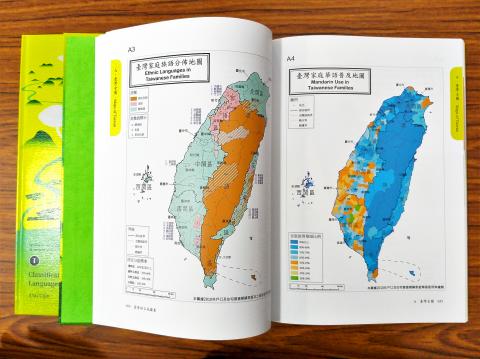A book on language geography reveals the linguistic and cultural diversity of Taiwanese society, author and linguist Hung Wei-jen (洪惟仁) said on Monday at a launch event in Taipei for A Study on the Geography of Taiwanese Languages (台灣社會語言地理學研究) published by Avant Garde.
Language geography, or the study of the geographic distribution of languages, is one of the most significant trends in linguistics and geography, but Taiwanese academia has not begun to tackle its theory, practices or ramifications, Hung said.
His latest, two-volume work is an attempt to fill the gap in Taiwanese academic discourse on the subject and is based on more than 30 years of field work and analysis that “traces the boundaries of Taiwan’s many spoken languages and dialects,” he said.

Photo: Chen Yu-hsun, Taipei Times
The first volume, titled “The Taxonomy and Distribution of Taiwanese Languages: Theory and Methods,” lays the theoretical groundwork for the study, he said.
The second volume, “Taiwanese Topographical Maps of Taiwanese Languages,” is a collection of 105 colored maps and deals with the spatial distribution of languages, including Hoklo (commonly known as Taiwanese), Hakka and Formosan languages, as well as some less common tongues.
At the highest level of detail, the maps display language groups in “natural villages” that exist within officially designated villages and boroughs, he said.
The topographical study of languages tells the story of four centuries of interactions between immigrants and native-born people that resulted in a diverse, multi-ethnic society, he said.

“China is preparing to invade Taiwan,” Deputy Minister of Foreign Affairs Francois Wu (吳志中) said in an exclusive interview with British media channel Sky News for a special report titled, “Is Taiwan ready for a Chinese invasion?” the Ministry of Foreign Affairs said today in a statement. The 25-minute-long special report by Helen Ann-Smith released yesterday saw Sky News travel to Penghu, Taoyuan and Taipei to discuss the possibility of a Chinese invasion and how Taiwan is preparing for an attack. The film observed emergency response drills, interviewed baseball fans at the Taipei Dome on their views of US President

The Central Weather Administration (CWA) today issued a "tsunami watch" alert after a magnitude 8.7 earthquake struck off the Kamchatka Peninsula in northeastern Russia earlier in the morning. The quake struck off the east coast of the Kamchatka Peninsula at 7:25am (Taiwan time) at a depth of about 19km, the CWA said, citing figures from the Pacific Tsunami Warning Center. The CWA's Seismological Center said preliminary assessments indicate that a tsunami could reach Taiwan's coastal areas by 1:18pm today. The CWA urged residents along the coast to stay alert and take necessary precautions as waves as high as 1m could hit the southeastern

The National Museum of Taiwan Literature is next month to hold an exhibition in Osaka, Japan, showcasing the rich and unique history of Taiwanese folklore and literature. The exhibition, which is to run from Aug. 10 to Aug. 20 at the city’s Central Public Hall, is part of the “We Taiwan” at Expo 2025 series, highlighting Taiwan’s cultural ties with the international community, National Museum of Taiwan Literature director Chen Ying-fang (陳瑩芳) said. Folklore and literature, among Taiwan’s richest cultural heritages, naturally deserve a central place in the global dialogue, Chen said. Taiwan’s folklore would be immediately apparent at the entrance of the

ECONOMIC BENEFITS: The imports from Belize would replace those from Honduras, whose shrimp exports have dropped 67 percent since cutting ties in 2023 Maintaining ties with Taiwan has economic benefits, Ministry of Foreign Affairs officials said yesterday, citing the approval of frozen whiteleg shrimp imports from Belize by the Food and Drug Administration (FDA) as an example. The FDA on Wednesday approved the tariff-free imports from Belize after the whiteleg shrimp passed the Systematic Inspection of Imported Food, which would continue to boost mutual trade, the ministry said. Taiwan’s annual consumption of whiteleg shrimps stands at 30,000 tonnes, far exceeding domestic production, the ministry said. Taiwan used to fill the gap by importing shrimps from Honduras, but purchases slumped after Tegucigalpa severed diplomatic ties with Taiwan